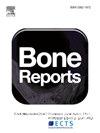在小鼠中,骨机械负荷降低心率并增加心率变异性
IF 2.6
Q3 ENDOCRINOLOGY & METABOLISM
引用次数: 0
摘要
心血管疾病和骨质疏松症在临床上是相关的。骨骼通过改变其整体结构和质量来适应机械力。作为对机械应变的反应,骨细胞释放信号分子并激活神经系统。骨骼还具有调节包括心脏在内的许多组织的内分泌功能。我们假设骨机械负荷通过神经和/或内分泌机制剧烈改变心功能。为了验证这一假设,我们对麻醉小鼠进行了体内胫骨机械负荷,同时使用心电图(ECG)监测心脏参数。在成年雄性和雌性小鼠的胫骨负荷期间,观察到静息心率立即短暂降低(p <;0.01),同时心率变异性(HRV)增加(p <;0.01)。心电图间期、PR、QRS和QTc均不受负荷影响。在进一步的研究中,我们发现至少需要3n的负荷才能在成年小鼠中引起这种心脏反应。随着年龄增长到11-12个月,心脏对负荷的反应变得迟钝,这表明这种骨-心联系可能会随着年龄的增长而减弱。在胫骨周围施用利多卡因显著降低了对骨负荷的心率反应(p <;0.05)。此外,交感拮抗剂心得安预处理可抑制这种心率对负荷的反应(p <;0.05),而副交感神经拮抗剂阿托品没有(p >;0.05)。这表明后肢的神经元传入通路和传出交感神经张力的减少介导了这种骨-神经-心反射。总之,胫骨骨负荷年龄依赖性调节心脏功能的研究结果支持了骨骼和心血管系统生理耦合的概念。本文章由计算机程序翻译,如有差异,请以英文原文为准。

Bone mechanical loading reduces heart rate and increases heart rate variability in mice
Cardiovascular disease and osteoporosis are clinically associated. Bone adapts to mechanical forces by altering its overall structure and mass. In response to mechanical strain bone cells release signaling molecules and activate the nervous system. Bone also exhibits endocrine functions that modulate a number of tissues including the heart. We hypothesized that bone mechanical loading acutely alters cardiac function via neural and/or endocrine mechanisms. To test this hypothesis, we performed in vivo tibia mechanical loading in anesthetized mice while monitoring heart parameters using electrocardiogram (ECG). An immediate, transient reduction in resting heart rate was observed during tibial loading in both adult male and female mice (p < 0.01) with concurrent increases in heart rate variability (HRV) (p < 0.01). ECG intervals, PR, QRS and QTc were unaffected with loading. In further studies, we found that at least 3 N of load was necessary to elicit this heart response in adult mice. With aging to 11–12 months the responsiveness of the heart to loading was blunted, suggesting this bone-heart connection may weaken with age. Administration of lidocaine around the tibia significantly diminished the heart rate response to bone loading (p < 0.05). Moreover, pre-treatment with sympathetic antagonist propranolol inhibited this heart rate response to loading (p < 0.05), while parasympathetic antagonist atropine did not (p > 0.05). This suggests that a neuronal afferent pathway in the hindlimb and reduction in efferent sympathetic tone mediate this bone-neuro-heart reflex. In conclusion, the findings that tibia bone loading age-dependently modulates heart function support the concept of physiological coupling of the skeletal and cardiovascular systems.
求助全文
通过发布文献求助,成功后即可免费获取论文全文。
去求助
来源期刊

Bone Reports
Medicine-Orthopedics and Sports Medicine
CiteScore
4.30
自引率
4.00%
发文量
444
审稿时长
57 days
期刊介绍:
Bone Reports is an interdisciplinary forum for the rapid publication of Original Research Articles and Case Reports across basic, translational and clinical aspects of bone and mineral metabolism. The journal publishes papers that are scientifically sound, with the peer review process focused principally on verifying sound methodologies, and correct data analysis and interpretation. We welcome studies either replicating or failing to replicate a previous study, and null findings. We fulfil a critical and current need to enhance research by publishing reproducibility studies and null findings.
 求助内容:
求助内容: 应助结果提醒方式:
应助结果提醒方式:


